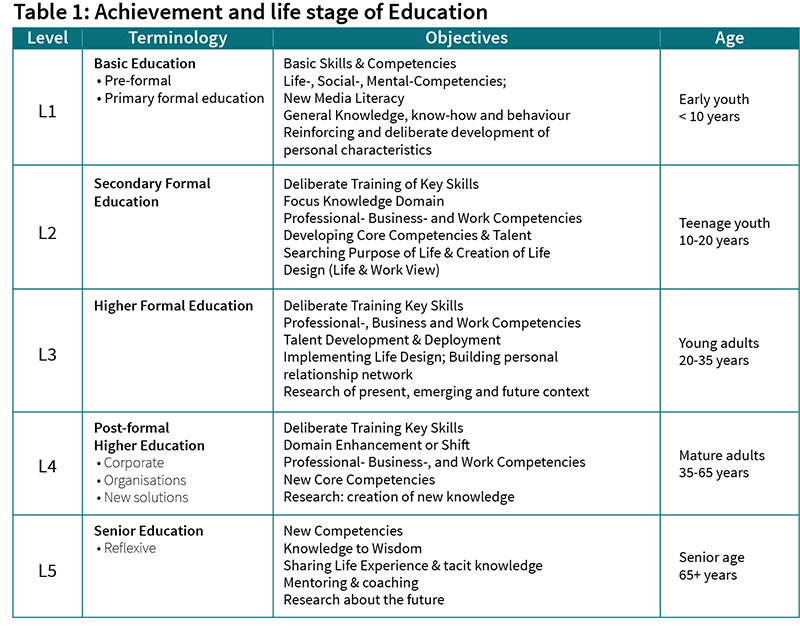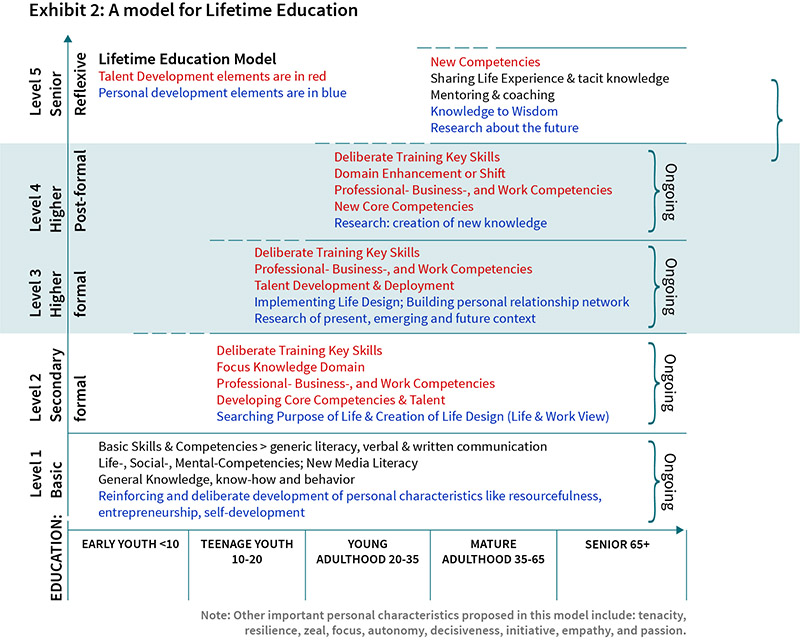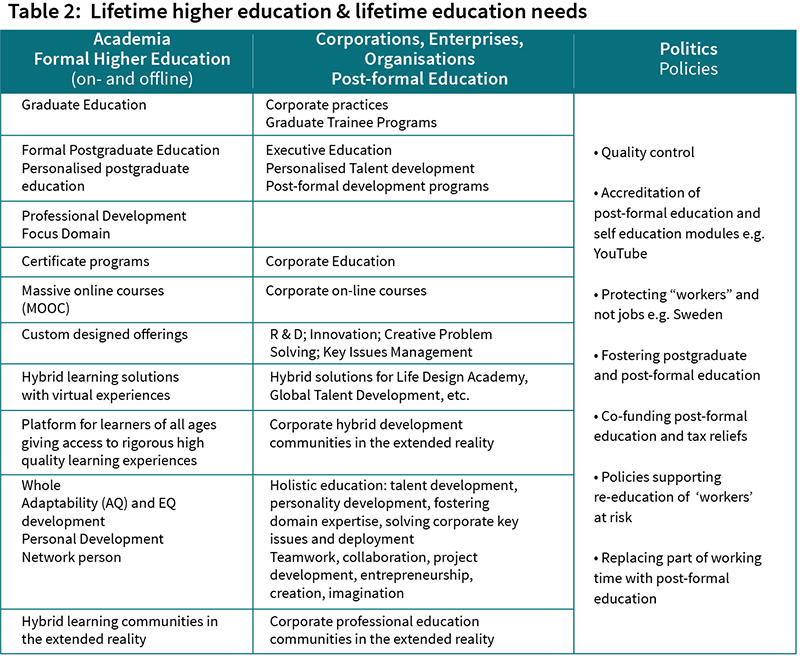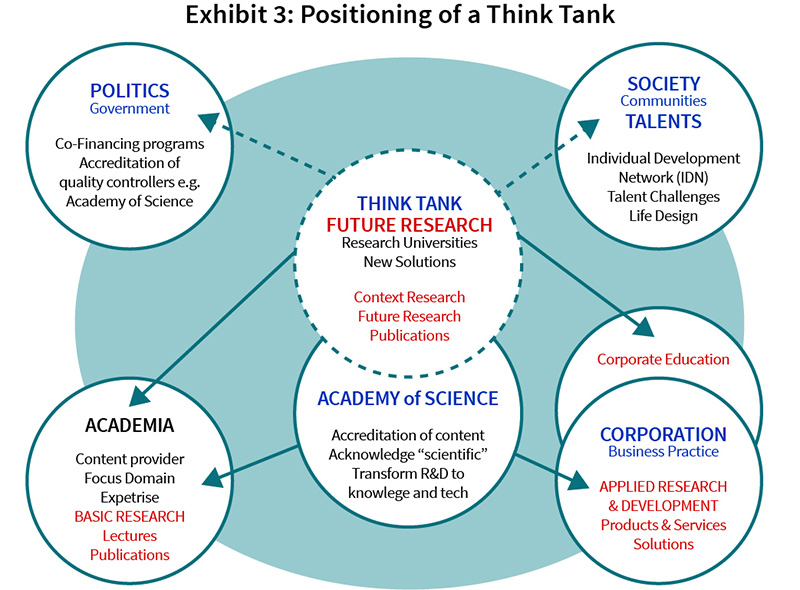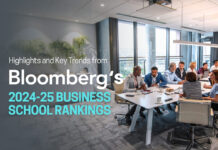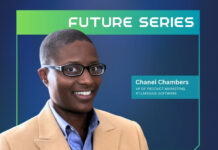By Mario Raich, Simon Dolan, Paweł Rowinski, Claudio Cisullo, Courtney Abraham and Jan Klimek
“Education is a sustainable way for cultural change and transformation.”
The world around us has already changed dramatically, and the pace is accelerating exponentially. So far, the so-called “education” has not been able to catch up with this fourth industrial revolution. Visionary people are already looking beyond it, talking about the “age of transhumanism”1. In view of the accelerating development of Artificial Intelligence (AI) and Cyber-Reality (CR) it becomes mandatory to define human uniqueness vs. intelligent machines and Cyber Entities.2 The new reality requires a lifetime education model, which is truly future oriented, and proposed to be based on four pillars: learning, research and design, development and deployment. This article stretches our imagination and hopefully will serve as a creative reference allowing educators to dream and deploy new systems.
INTRODUCTION: REVISITING THE FUTURE
Curiosity and the joy of creation are the power engines of education!
If we look 25 years into the future from now, we can see a different world. The Cyber-Entities are supporting people everywhere and in all aspects of daily life and work; in politics and arts, in science and technology, in education and in entertainment; in “Our-Reality” (subjective) and in the Cyber-Reality (objective). It is a useful co-existence and collaboration, which has become an integral part of human civilisation. Robots and smart machines are taking care of large part of the physical and administrative work. A large part of the human population lives and works extensively in the Hybrid Reality composed of “Our-Reality” and “Cyber-Reality”. The lifetime education is also increasingly shifting into the Cyber-Reality.3
With the Virtual-Reality becoming seamless to Our-Reality, the boundaries between the different realities are increasingly blurry, the world has dramatically changed. Additionally, physical and mental abilities have been augmented thanks to advanced technologies and techniques. The mentally enhanced humans are considered as the intellectual elites with coaching and mentoring duties towards the rest of the population. They create the talent pool of scientist, technicians, engineers, future researchers and future designers, but they may also include some selected politicians and spiritual leaders.
People have become very “Cyber savvy”. The use of the highly sophisticated and smart technology has become quite easy to handle. The social and professional life is shifting increasingly into the Virtual Reality. So are the crime and even wars. In countries ruled by powerful Lords the advanced technologies are also used for control of the citizens.
Almost all areas of life have changed or are in the process of being changed. Sustainability of nature and natural resources is the leading principle of the hybrid civilisation. Transportation, heating, cooling, lighting and the production of packaging and all kinds of wrapping no longer require fossil fuels. New solutions have replaced plastics. Circular supply chains are enabling permanent reuse of most raw materials. The production of food has shifted to the cities and to food producing factories. Animals are not needed anymore for the production of meat. Cities, countries and enterprises are competing in the race for self-sustainability and zero carbon footprints. The cleaning up of the environmental mess created by the exhaustive capitalism of the 20th century and the beginning of the 21st century, and the transformation towards an environmentally sustainable society have created an incredible amount of new jobs. The big challenge is how to maintain a level of comfort and prosperity, keeping a satisfactory quality of life in balance with the finite resources available and a biosphere with its life friendly durable ecosystems.
All of these require an incredible amount of human imagination to create and implement new solutions. Luckily the virtual labs and future design centres allow to experiment new solutions without causing a real harm to the environment.
Imagine that Lea is a digital native; she is in the mid thirty, born at the time when the iPhone was introduced to the market. Her parents were both active in the ICT industry. She grew up with an iPad and a Smartphone in her hands. Social Media, YouTube were her companions from early days on. At the time when digitalisation was raging, she was still at school. It was a traditional school where digital devices were not welcome. She was still pursuing her formal education, preparing her master, when augmented reality was spreading fast into the industry and was slowly introduced into education. Like all other students, Lea passed through the talent assessment and led a talent challenge project in scientific research at the beginning of her studies. She found out that her talents would be best deployed in applied research. At the same time, the development of virtualisation was picking up speed on its way to “seamlessness” with “human reality”. The breakthrough came, to the big surprise of experts, because of the deployment of VR in medicine helping to contain the cost explosion and for virtual sex due to the lack of women in several large countries, the unwillingness for sex of the young generation in some other countries, and the draconic laws for sexual harassment in the so-called developed world. Advances in Artificial Intelligence were also spreading into the workplace and daily life. Education was still reluctant to fully leverage it. Education was still focussed on learning, but the importance of transmission of knowledge was already vanishing. The world was clearly in transition. Lea opted to work in the area of care and repair of the environment. But before she started to work in the environment cluster, she went through an extensive virtual simulation about the first ten years of engagement. She also took several “virtual practices” in this domain. Additionally, she also started to create her own individual development network. When Lea finally joined the “workforce”, the idea of lifetime education started to become reality. The concept of education was extended towards the four pillars approach: learning, research & design, development and deployment. Pilot programs for lifetime education have been deployed all over the planet, focussing in particular, on the “post-formal” education. The hybrid reality also started to impact work, daily life and education. People started to work in different realities: “our reality”, digital reality, augmented reality, and virtual reality. Since Lea has a master in “Care and repair” with a focus on environment and a specialisation in water, and she is a sustainability engineering scientist, she started to work as a research scientist in the “Environment Care and Repair Core Competency Cluster”. The work on “environment” is a global key issue, and is encompassing the areas of air, water, soil, climate and the living nature. In view of the catastrophic situation of almost all eco-systems, most people activities are shifting into the virtual reality. But the world disasters needed to be taken care of in order to recreate sustainable environment for life. Human species are at risk! Growing number of people started to work on projects aiming at leaving the planet and moving into space and other planets of the solar system. There was even a hope to move someday soon to planets around nearby stars. Lea has an assigned Cyber-Entity watching the status, monitoring her talent development, and ensuring she was up-to-date on the scientific and technological development relevant to her professional activity. In addition she is an active member of several professional networks and participates in the educational activities of the “Global Virtual Academy” in the areas of sustainable development and environmental care and repair. Finally, she is preparing for future research in these areas.
REDEFINING EDUCATION: TOWARDS A CONCEPT OF EDU-ECOSYSTEM
“Imagination and dreams are an important part of our life; they must have their place in our education as well.”
So, we wish to propose the four main processes that altogether encompass education:
1. Learning, relearning and unlearning knowledge, know-how and expertise. The example of our role models may have a big impact too.
2. Research, search, exploration, discovery and design. Exploration of the future and creation of a vision of the desired future of life purpose; who we are; what do we want to become, etc. (= Future View)
3. Development. Deliberate purposeful training and development of core skills, abilities and competencies. Personality development helps the person become mature, responsible member of the community.
4. Deployment. Application of core competencies in practice and further development. In this way the core competencies are becoming talents. Experiencing real life situations. Continuing to learn, research and develop enhancing talent and enlarging its scope.
In other words: Learning should lead to focus on selected domain expertise. Research, should lead to the development of a mature, self-driven personality. Development and deployment of the core competencies will facilitate the development and creation of talent. One needs to remember that this is an ongoing process and can occur simultaneously. The same four processes are necessary for transformation (changing existing into something new) and innovation (creating new values). Some scholars separate personal development from competencies in explaining the development of talent but we think this is artificial. In reality they intertwine with each other.
Education is a lifelong process causing an inherent and permanent change in a person’s thinking and capacity to do things. Education is enabling a permanent adaptation to changing life circumstances. Education goes far beyond school and teaching.4 All of us are confronted with formal and informal education. The main objective of education is the development of mature, self-responsible personalities, able to cope with the challenges of life. Education also helps in the development of personality and competencies necessary and useful at all stages of life.5 It helps to develop and to deploy creativity and entrepreneurship for a successful life. Education plays also a key role in the development and maintenance of the fabric of human society.Well-educated people are enhancing life quality of the society. Education is a life-long mesh of activities and experiences necessary for development of skills, knowledge, know-how, expertise and competencies, talents, personality, in addition to development of thinking, reflection and the ability to do things. And here are four short quotes attributed to Albert Einstein when made references to the system of education during his era (and unfortunately it has not been radically changed since). We really insist that Einstein’s observations are still valid today: •“Education is what remains after one has forgotten what one has learned in school.” •“Imagination is more important than knowledge.” •“Knowledge of what is does not open the door directly to what should be.” •“The only thing that interferes with my learning is my education.”
Edu-Ecosystem
Edu-Ecosystem encompasses all the elements described in Exhibit 1: It includes formal and post-formal education, Edu–Platform; Edu-Guide, Personal Development Network; Development & Talent Communities and peer support.
We are living through moments of deep transformation in education. We argue that higher education will and should not be left to academic institutions alone, but should encompass other players such as corporations (i.e. corporate education and executive education), as well as new institutions. Some corporations and enterprises will become new important players in the new higher education. Lifetime learning, and unlearning, development and transformation are here to stay. The time of more of the same seems to be over.
Peter Diamandis, best known for being founder and chairman of the X Prize Foundation, cofounder and executive chairman of Singularity University, presents a fascinating future model for future education based on five guiding principles: Passion; Curiosity; Imagination; Critical thinking and Perseverance in pursuit of long-term goals.6 He also presents a fascinating layout of modules and deployment of exponential technologies in classrooms. Although his model is addressing elementary school level, we believe it is also applicable for later stages of education.
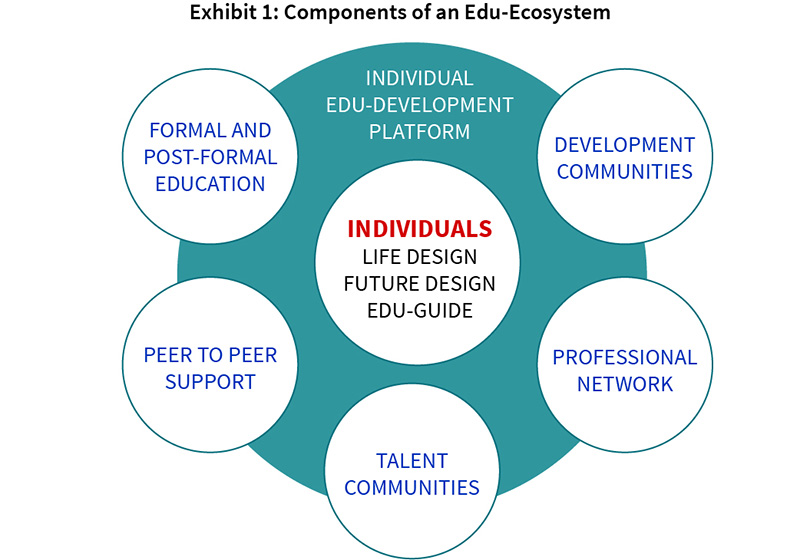
LIFETIME EDUCATION (LTE)
“The expected future is highly uncertain and fragile. We can either anticipate and explore the future of education, or create it. This is our choice.”
What a pity that at times when many existing working activities are/will be taken over by AI-based machines and robots, we are still focussing our education on traditional skills and competencies. To cope with continuous contextual changes, the disruptive impact of unexpected transformation and innovation and the expected fully developed Cyber-Reality, we need a life-long education model. Thus, the big challenges that needs to be addressed relates to “Lifetime Education”. It will be characterised by cycles of unlearning and re-learning at the pace of constant innovations generated by Cyber-Reality and fast developing Artificial Intelligence.
Worthwhile to note the following in supporting our argument:
•There is a generic shift from pure learning towards research, development and finally deployment.
•The “non-formal” education which goes beyond any formal education (and this applies to all ages) needs to be enhanced and intensified.
•Self-driven education needs to play an essential role in all kinds of educational activities.
•Personal development needs to be intertwined with the competency and talent development.
The two main drivers of education are achievement of a level and the life stage. Education needs time for the corresponding experiences and the deployment of developed competencies.
We propose a new terminology for the different stage’s lifetime education process as depicted in Table 1 and the full model is shown in Exhibit 2.
In order for the model to be fully understood, it is necessary to organise individualised life-long learning and development into levels, stages and scope in order to secure relevance and meaningfulness of education. Higher Education plays a particularly important role because it takes care of key talents. But for it to be effective, it needs to focus on individuals and be extended way beyond the traditional time frame, in parallel to the lifelong talent development, as well as work on the development of our personality. Personality development is the relatively enduring pattern of thoughts, feelings, and behaviours that distinguish individuals from one another.7 Personality is what makes a person a unique person. Everyone has his/her own pace of development and a specific talent. Talent Groups and professional development communities can be useful to gauge own development.
Changes in the composition of the work environment – the emerging workforce consists of a mix of people, robots and Artificial Intelligence based programmes and entities and there is the need to create new jobs which will replace the digitalised ones and to provide work for the growing population – a new definition of workplace seems to be emerging.
The most critical period for the development of talents takes place during the so-called “higher education”. Thus, we argue that talent development will become the core element of higher education, which will be extended at least for the time of active working. We further argue that education should focus on individuals, because only individuals have talents. An innovative way for individual talent development connected to organisation development is what we label “collateral talent development”. The latter was recently designed by the e-Merit Academy. There, an explanation is offered on how to create a process for which talent development practices will be spread across all levels of the organisation and their eco-system. This will eventually lead to a transformation of the organisational culture that will become more innovative and experience higher levels of entrepreneurship.
The proposed model for life-long education (Exhibit 2), can serve as a blueprint for the talent development path. One thing is certain – current education cannot do the job. As talent development and deployment will play a key role in the future, extended higher education will have to come to bear. However, it needs to be connected to the contextual changes and personality development.
Hess and Gozdz claim that organisations will need to become “hyper-learning communities” and leaders enablers of human development and large scale-hyper-learning.8 We would add to their assertion only the following: “with focus on individual development and in partnership with the Cyber-Entities”.
ON THE FUTURE HIGHER EDUCATION
“Passion is certainly one of the strongest drivers for our actions. But passion is like fire: it can warm or burn us.”
Top Universities’ administrators and presidents suggest that the contemporary university will fundamentally be transformed by distance education and technology, mass enrollments, increasing vocational-focussed programs, and privatisation. The early 21st century is a period of both crisis and transformation for higher education globally. And it is entirely possible that some sectors of higher education will change fundamentally or risk at vanishing altogether.9
One more time – What is the purpose of Higher Education?
Development of professional talents requires academic focus domain, (i.e. advanced and deep knowledge in a discipline, know-how and expertise). On the top of it, and based on learning, research/life design, development and deployment, competencies for the development of real talent can be rendered.
Deployment and achievement serve also to test the development level of talents. Competency and talent certification can also serve as confirmation for readiness of employment and career steps.
Regular reviews and specific challenge projects are securing the actuality and relevance of claimed ability to perform. This is confirmed by “Re-certification”. And the latter, can probably be replaced by relevant achievements in practice.
Levels: Promising talent, junior talent, advanced talent, senior talent, and mature talent.
Similar steps may exist for development for academic career. Professors will be increasingly becoming: tutors, coaches, designers and finally mentors. Focus will be on individual talents with supervision and support. Regular progress reports based on achievements corroborated by peers, customers and superiors will be issued.
In the future, we will need a two-tier higher education, with a dynamic balance of academic and corporate involvement. It will be a kind of “dual higher education” with two stages: formal higher education and post-formal education. Both levels will be using collateral education, peer consulting and tutoring; creation of personal education networks (PEN). Higher education, thus, must be based on the four proposed processes.
Formal higher education will be driven by the “academia”, led by professors and academic tutors, focusing on deliberate skills training, knowledge, know-how and expertise of the focus domain and its eco-system. In addition amply interim assignments in corporations and organisations should be available. Every “student” will have to make a talent assessment and perform a Talent Development Project. The transformation of Higher Education will also encompass the faculty. Professors will also be increasingly learning from their students.
Today the best example of practice oriented higher education is the “Fachhochschule” (University of Applied Sciences and Arts), a type of higher education that emerged from the traditional Engineering schools, highly popular in Germany, Switzerland and Austria, focussed on practical knowledge or industry oriented studies.10
Corporations and other nonacademic organisations, led by executives and professional coaches, will drive post-formal Higher Education. The main aim is to deepen the domain expertise by exposure to corresponding practice; deliberate training of core skills in particular, with respect to the core competencies; development of core competencies and deployment within the focus domain. This will lead to talent and personality development with supervision by academic tutors, based on specific Talent Development Projects. This allows also improving the skills of collaboration. In such manner, the Higher Education Institutions will be ready to better prepare students for a transformed and increasingly challenging workplace. Development of everyone goes on her/his specific individual pace and progress. The milestones of progress are achievements.
To cater to changing requirements, formal society and business Higher Education Institutions will need to create alliances with leading media, social media and corporations focussing on corporate core competencies. This may be linked to the creation of corporate core competencies clusters. This will qualify them to participate in the post-formal education as well.
Postgraduate programs will become the bridge between academia and real life (e.g. corporations). But they will have to bear practice and experience orientation. They need to include: collaboration, cooperation, partnership, teamwork, co-existence and communities based on three elements: common ground, open communication, mutual trust and respect. Successful “togetherness” requires those three key elements.
Some ideas for postgraduate programs
Postgraduate programs: e.g. Talent development based on Talent Challenge
•Talent Academy as Talent Forgeries: executive talents, professional talents, etc. Development and offering of specific talent development
•Leadership Development; Business Leadership, Political Leadership, Social Leadership, Strategic Entrepreneurship etc.
•Talent development communities
•Programs created from the merger of academic, corporate education and gaming technology: Simulations; Challenges; Life Design; Future View; Interactive Videos; VR journeys and explorations; VR Labs; Future anticipation, exploration and design
•Hybrid solutions for Life Design Academy, Global Talent Development, etc.
Education Dilemma
So far we have proposed a shift from education that focusses only on learning in classes towards development of individuals. But education is also creating the fabric of society and communities. Thus, it needs to take care of development of collaboration and co-creation of humans, and humans with Cyber-Entities. It needs to develop people’s empathy to overcome the raging egoism and “me first” attitude.
Ideas for solutions
•Everyone creates his/her personal education network (PEN)
•Individuals are encouraged to make development experiences in diverse, different communities
•Development of community specific characteristics e.g. empathy, responsibility for others, collaboration and co-creation
•Shift from classes towards communities of mature motivated, self-responsible individuals. This is particularly important for higher education and the postgraduate education
•Create development communities for life-long education with common development needs
•Involve people in the “reflexive age” for coaching and mentoring of such communities
An interesting example are the highly successful programs form the MTA (Mondragon Team Academy): An undergraduate Leadership, Entrepreneurship, and Innovation Degree; a postgraduate International Executive Master Program in Intrapreneurship and Open Innovation, and the Team Mastery Training: A program to start, train & become an MTA certified Team Coach.11
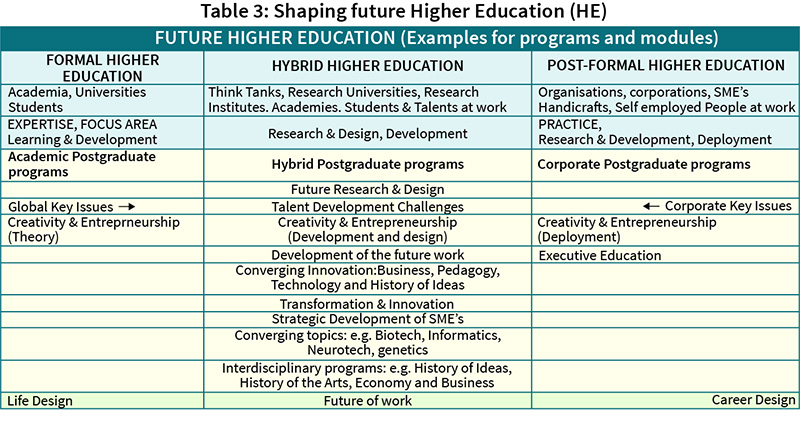
Can think tanks be part of the solution for post-formal education?
A Think Tank is an organisation with the purpose to provide interdisciplinary research and advice on selected specific issues using specialised knowledge and knowledge platforms.
Think Tanks will play an increasingly important role as intermediaries between academia and corporations, due to the ongoing transformation of the education and the necessary lifetime education. They may even play a major role in higher education. The Think Tanks could create, together with an associated academic institution, global postgraduate development programs. They will also elaborate “Future views” for specific topics and make recommendations.
The Adecco Group is the world’s leading HR solutions provider and a Fortune 500 Global Company. It has developed some highly interesting innovations in this area.12 They are oriented towards making the future work for everyone.
How is the Adecco Group impacting Education?
•The Adecco Group is hosting “Work Days” on own campuses globally where youth aged 10+ join to learn about our environment, the types of careers that exist and shadow a variety of our colleagues. The participants can develop together solutions for talent challenges based on a real life scenario. In 2018, the Adecco Group employees became mentors for one day, sharing their expertise with thousands of young people. 4,000 colleagues participated. 8,000 youth had a work experience. 47 countries celebrated Experience Work Day.
•The “CEO for 1 Month” program is providing outstanding opportunities to talented young people around the world. As a career beginner, it’s often difficult to find a job because of a lack of work experience. With “CEO for One Month”, the Adecco Group addresses this issue and offers young people an exceptional opportunity for a special kind of beginning to their career. The finalist will not only gain work experience during his/her internship but will also be given the unique opportunity to skip a few steps on the career ladder and get a glimpse of a position that would normally take years to reach, and would usually require a wealth of professional experience and very specific circumstances.
Each year, the Adecco Group opens the application process around the world to apply to be CEO for One Month in local countries where they do business. The finalists are invited to interviews and assessment bootcamps. The applicants are assessed on a wide range of skills.
“CEO for One Month” runs in 47 countries, where the first step for candidates is to apply to become CEO for One Month in their country of residence, before making it to a shortlist of 10 top performers. Of the final 10 candidates, 1 will be chosen to become Global CEO for One Month. Very strong applications are also considered for exciting internships through our brand network of companies where we actively place talent on assignments and exciting future opportunities.
In 2018, the 47 CEO for One Month nominees from all of our countries competed for a chance at the helm of our global organisation. This Global CEO for One Month works under the direct supervision and mentorship of our very own Alain Dehaze, CEO of the Adecco Group. The selected Global CEO for One Month gains a taste of how to run a multinational company with 34,000 employees and 20 billion euros in revenue. The highly qualifying experience could be a huge boost to any career!
How is the Adecco Group leading innovation in the world of work?
The Adecco Group’s purpose is to make the future work for everyone – that means embracing innovation, investing in innovation and leading innovation. Innovation is one of the core pillars of the Adecco Group’s corporate strategy – Perform, Transform, Innovate. The Adecco Group employees are encouraged to innovate, here are some outcomes:
•The pioneering recruitment-on-demand app Adia was the brainchild of a former CEO for One Month finalist Ernesto Lamaina
•YOSS – our groundbreaking freelancer platform – was co-founded by another TAG team member Guillaume Herrnberger •Adecco has established AGX – an in-house digital incubator to pilot and deliver new solutions and services e.g. YOSS
•Through collaboration with industry leaders – Microsoft (YOSS)/ Infosys (Adia)
•Adecco’s Foundation acts as a social innovation lab to improve workforce vitality and support the work readiness of underserved populations
•Adecco’s is embracing technology in the way it operates in-house – transforming our systems to improve how we deliver our services
•Offering the kinds of talent services and support that Adecco’s customers need to innovate in today’s changing world with:13
– Up- and re-skilling through General Assembly and Lee Hecht Harrison
– YOSS and Adia – solutions to innovate how we connect for work
– A 360 degree ecosystem that covers the entire work-life cycle
Extending the ADECCO experience: Some reflections
Some of the Adecco Group’s programs could be developed into collateral programs spreading the learned practices across the entire organisation. The key elements of collaborative education are: self-education; tutoring peer-to-peer; and finally, top-down coaching and mentoring. Simple techniques like constructive feedback; collaboration and cooperation; creative problem solving; etc, introduced for working teams and project teams as well available on-line are powerful enablers and drivers.
The “CEO for One Month” could be expanded towards all executive core competencies, covering leadership, entrepreneurship, management and business acumen. This could be the beginning of collateral leadership development.
Another excellent element would be the creation of an Executive Future Board with young executives focussed on future business, with mentoring and coaching of their corresponding holders of functions on the Executive Business Board.
Finally, the collateral Talent Development as offered by e-Merit Academy could be a boost for AGX the Adecco innovation incubator and a key step towards post-formal education.
Role of Academies of Sciences and Research Universities
It is rather unusual to discuss the role of academies of sciences in the context of education, but we are convinced that missions of the academies of sciences will orient (if not doing so already) towards educational matters. Note that even today some academies emphasise their educational mission, e.g. French Academy of Science mention in its Status the mission to watch over the quality of science teaching and take action in order to facilitate the achievements of scientific development to pervade the human culture of our times. The concerns of the Academia are not only related to the training of future researchers, but they also include the objective that all pupils acquire high scientific culture, which will be vital for them as they grow into responsible citizens. ALLEA, the European Federation of Academies of Sciences and Humanities, fulfills its mission among others, through working groups. One of them is the ALLEA Working Group on Science Education, focussing on fostering science education and improving its quality by raising the awareness of politicians about the importance of science education.
Nonetheless, academies of sciences throughout the world have different structures and roles. In some countries they are basically learning societies consisting of the elite distinguished groups of scientists but in other countries they are an umbrella organisation for research institutes (e.g. Austrian Academy of Sciences, Polish Academy of Sciences). When academies play a role of research centres there is a vivid debate whether to transform it into the best educational institutions in their countries. For example, a domestic discussion has recently swept through Poland whether to create a new university that will not compete against existing domestic universities but serve them by fulfilling the role of a centre of scientific and academic excellence. Such a university could be formed by harnessing the potential of the institutes affiliated with the Polish Academy of Sciences. It is being designed as multidisciplinary and international in its nature and it is claimed that it should systemically provide services for other higher education establishments in Poland and act as a centre of excellence that can be used and benefit from. Such institution should have a lightweight, central structure, and its institutes should enjoy a high degree of autonomy, necessary for the implementation of independent research missions and “agile” management. No matter if the project turns out to be a success in the nearest future, it seems to be a desired kind of mission within the anticipated educational ecosystem of the future.
Irrespective of the current structure of an academy of sciences, it seems that in the future they all might play a role as quality assurance in education. Academies are the only highest-level organisations independent of educational system itself that are qualified to accredit educational curricula and contents at various levels. Whether or not some academies of sciences will transform into research universities, such institutions will increasingly be created in various countries since it becomes clear that “in a knowledge intensive society, the research university is a key institution for social and economic development”.15 The key feature of such institutions is the production of new knowledge. Chan (2016) argues that “university research is now the most powerful impulse for human progress” and as such cannot be forgotten in the debate on future education.16 There are cases of completely new institutions of that kind and it seems they might constitute a kind of a vertex on an educational path. A good example is Okinawa Institute of Science and Technology, which aims to contribute to the development of science and technology worldwide by conducting internationally distinguished education and research. Such institutions foster a global innovation ecosystem to create new businesses and industries based on R&D on one side and are also excellent platforms for developing various kinds of talents.
Other possible new education entities
•Hybrid, individualised, but part of teams, communities and circles
•Edu-Tanks, Hybrid social circles; Talent championships
•Virtual Education Academies for specific core competencies and talents
•Cloud Education securing access to education for remote areas for free
•Global Virtual Meta-Network encompassing many education networks and entities. A kind of “Virtual Education Amazon”
•Global Virtual Academy. Virtual practice; Life preview: design options choice decision preview of potential future 5-20 years
•“Virtual art” → virtual role play
•“Cyber Education Academy” encompassing Universities and Research Universities
Postformal education for non-academics
Beside the big gaps in lifetime education for people with higher education between mid twenties and mid sixties, there is another even bigger gap; it is the education of people without academic degree after their formal basic education. This is the case for most of the employees of the large corporations, the SMEs, the self-employed and the handicraft workers. They have decades of work and life experience but their activities and even jobs may be at risk to be taken over by smart machines and robots. According to McKinsey Report “Jobs lost, jobs gained: What the future of work will mean for jobs, skills, and wages in 2030”, between 400-800 million people may lose their jobs, because of automation, but also 375 million people will have to switch their occupation and learn new skills.17
The big question is how to secure lifetime education for this kind of working people, and keep them employable. The most urgent issue is certainly to make them digital savvy, able to work in a digitalised environment and to collaborate with the Cyber Entities.
What could the Higher Education look like and contribute to employability? Could it be collateral education, or perhaps, peer to peer, assigned experts?
Could working people exchange their know-how and experience against education provided by qualified people from younger generations? Should qualified students after their studies be paid for a six to twelve months practice helping working people to enter the digital and subsequently to the virtual age? How could virtual practice-oriented programs look like and help sustain employability?
At the same time, there are many jobs where skills required are unique; jobs that need creativity and imagination like hairdressers, designers, photographers, and carpenters. Customers nowadays are looking for new, different, unrepeatable solutions, handmade product. Therefore in many countries skilful people for this kind of jobs are needed, well paid and hard to find. Currently there are not sufficient talented craftsmen to address the needs, so imagine what will happen if the vast majority of people focus on competences in the digital and virtual sectors. It seems that very soon talented craftsmen, whose work is comparable with artistic jobs, will be unique, even better paid and always desirable.
Therefore, we need to make sure that education system in vocational schools is not being neglected and meets the following requirements:
1. Enhance the perceived and real value of the vocational jobs. For example with certificates from higher education institutions. Offer such certificates along the lifetime education.
2. Open up avenues to higher education for people with several years of practice, based on their working experiences.
3. Create lifelong career counselling.
4. Facilitate access to the newest technology, technology labs, and new solutions in practice.
5. Implemented system of lifelong education, create lifelong education centres combined with update and know-how exchange. Secure access to coaching during and after studies.
6. Make sure that teachers are aware of their role and requirements.
7. Education programs should be flexible and easily manageable, there is a need for mechanism that would allow changing programme according to the needs of the market, employers and environment. Vocational education has to follow the needs of the market.
8. The development of soft-skills should be mandatory part of vocational training.
Certainly people at work will need more self-responsibility and self-development in their on-going education. The real big issue is, what can be transferred into the work of non-vocational workers, and what role could Higher Education play in this respect. This is a theme that we plan to address in a separate future essay.
THE CORE CONCEPT OF TALENT DEVELOPMENT
In the Cyber-Age, talents are the most valuable assets of the organisation. Talents are the guarantee for human uniqueness in business! They are the gems, which needs to be discovered, shaped and cut.
Talent
Talent is in its essence a successfully deployed core competency. A core competency consists of a core skill deployed within a focus domain of expertise. Development of skills needs intense deliberate training and practice.
Development of competencies of talents happens through recurrent deployment. The focus domain needs as well continuous learning, up-date and practice. We need to understand the “uniqueness” of people due to their personality and talents on one side and those of smart machines on the other.18 In addition we need to explore the synergies and the collaboration of people with smart machines. Probably there will not be an either-or situation. The smart machines will enter just gradually into many job areas enhancing people’s work. In general, it will be a rather complementary collaboration, rather than competitive one. But no doubt, there will be also total shift of many activities from people to Cyber-Entities.
Talent Development
A core competence based on a core skill can become a talent, but it takes a lot of deliberate training, development and deployment to get there. Talent deployment is purposeful application of talent within the selected domain of expertise. The milestones of progress are achievements in the deployment.
Talent development is an essential element of the Life-Long Education. It starts ideally in the teenage period. Then, any student entering the university should know and reassess what his or her talent is. This should become a mandatory module for all studies.
There is no talent development without the four pillars: Learning, Research, Development and Deployment. Therefore, higher education needs to support deep learning about the focus domain and related domains, reinforce deliberate training of key skills, focus on individual development, foster self-responsibility, enhance the development of personality, and take care of the development and deployment of core competences.
Future competencies and talents
The fast-changing context requires new competencies. We are experiencing growing uncertainty, volatility, complexity and ambiguity. Nevertheless, several things are visible:
•The increasing need for digital and recently virtual competencies and global connectivity
•Changing work environments. More and more people must work beside smart machines and even with them in a team.
•Increasing parts of the work are being taken by smart machines
•Growing need for collaboration and co-creation
•Higher focus on human competencies and talents
•The need for adaptability, Resilience, Scientific approach
Thus, the main individual competencies should include:
1. Life competencies (SELF): Generic and digital literacy, verbal & written communication, negotiation, critical and future thinking, imagination, creative problem solving, generic entrepreneurship, inner strength and resilience
2. Social competencies (OTHERS): Relationships, life partnerships, collaboration, trust & respect
3. Work competencies (WORK): Professional competencies; Leadership; performance, value creation, adaptation, collaboration and co-creation etc., techniques of the scientific research
4. Core executive competencies LEMBA (Leadership, Entrepreneurship, Management, Business Acumen) and executive key drivers APASO (Acceptance, Power, Achievement Status, Ownership)
If we look at the top key competencies required for work in five to ten years from now, we will find out that they are mainly related to specific human competencies:
•Thinking rational and irrational thinking, common sense & sense making, computational thinking, cognitive flexibility, finding creative solutions, complex problem solving, critical thinking, future thinking, design thinking, transdisciplinarity; also scientific thinking
•Social competencies (empathy, collaboration, virtual collaboration, negotiation
•Meaningful creation and destruction based on creativity and entrepreneurship and intuition based on empathy and imagination
•Meaningful and purposeful action based on free will and autonomy
•Caring (social and health caring, sustainability, service orientation)
•New media literacy (social media, visual media)
Collateral Talent Development (CTD) and Life-Long Education
Collateral development is spreading and sharing talent development know-how upwards, downwards and laterally to peers, infusing talent development practices into organisations’ culture. It begins with the focus on individualised talent development of executive talents completing an executive challenge with collateral development of competencies and talents of the project team. Later on leads to a rollout into the organisation.
The participants of the project team working on a Talent Development Project can be enabled to become coaches for talent development of their peers. Collateral development links talent development to solutions of organisational key issues and future development of the organisation. In this way they are creating and enhancing entrepreneurial spirit in the organisation. But this requires involving top executives from the organisation as mentors and coaches. In addition, external talents are also getting involved on a virtual basis attracting them towards collaboration with the organisation.
e-Merit Academy has created a new framework involving outstanding academics and executives, which helps talented executives and their firms deal with the new landscape that is shaping up due to the transformation based on digitalisation, virtualisation, and globalisation. It opens an important path towards the new world of Cyber Age.
This new way of development is designed and targeted for high potential executive talent. In the digital age information became a value. In the virtual age talents will have to be treated as value. The ability of partnership with the non-human entities will be of high value as well.
e-Merit Academy offers an innovative personalised Executive Talent Development, which is also linked to corporate development. It is labeled as: Collateral Talent Development. It is a new framework that helps talented executives and their firms deal with the new landscape that is shaping up due to the transformation based on digitalisation, virtualisation, and globalisation. It opens an important path towards the new world of Cyber Age. e-Merit Academy is supporting the in-house development of executive talents. The executive talents do not need to leave the company throughout the development.
just convenience more than a requirement. Computer savvy is a standard requirement for many jobs. Communication without smartphones is often not possible. In sum, the job mix will include the “old” jobs, modified jobs due to Cyber-Entities, and new jobs, most of them not known today.
It also means that we will have to deal with several major issues:
1. Continuous skilling and re-skilling of the workforce and reinventing talent development. This must be done within the lifelong education concept.
We need to develop models for the converging academic and corporate education.
2. Talent development will become the core element of the lifelong education.
This requires innovative talent development and deployment models.
3. Finding solutions to cope with the massive reduction of human work due to AI based automation and robots in the next decade.
Developing solutions like enlarging the scope of paid work to non-paid value creating activities, e.g. social, care homework; developing new working time models and models focussed on outcome; reduction of working time for humans and using more often flexible working time.
4. Change the existing tax system from income taxes to taxes on value and wealth creation.
New tax policies will be needed.
5. Prepare the workforce to collaborate with the Artificial Intelligence powered Cyber-Entities.
People must learn how to collaborate and co-create with the Cyber-Entities.
6. Getting ready for the AI based Cyber-Reality and dealing with social and political consequence
Start preparing for work in “Hybrid-Reality”economy where in 10-15 years most of the new jobs will be available in the Virtual-Reality. Key for this will be the“hybrid education”.
CONCLUSIONS AND IMPLICATIONS
“People have dreams, computers don’t! We need an education focussed on the desired future and not just on the expected one.”
Our world is in midst of digitalisation and is fast shifting towards a world dominated by virtualisation and artificial intelligence. People will work and live in collaboration with smart machines. This will lead to awkward distortions and disruptive contextual changes. We are at the dawn of a deep transformation with sizable scope that the world has never seen before; it is a world with fully developed virtual realities equipped with artificial intelligence. It is a journey into the big unknown and the bad news is that there is no way of going back. To cope with this deep transformation, we will need a life-long education that encompasses various forms and multiple levels of learning and applications.
The new landscape will embed four pillars that encompass education: learning, research, development and deployment. There will be a strong focus on individual personality and talent development. Talents are the most valuable human assets!
GFWF is a “non-profit organisation” created by a group of leading academics, C-Level Executives and Senior consultants, committed to develop concepts, methodologies and tools to educate and better prepare private and public institutions, as well as high potential talents, to the realities of the future. The idea was born following a series of discussions held, for which one common observation emerged: We are facing a lethal combination of three simultaneous forces that are transforming the landscape of tomorrow. Work in the future will never be the same. Most workplace stakeholders are ill-prepared or not prepared for this new workplace at all. These three forces that drives the transformation are: rapid advancement in digitalisation technologies, increased globalisation and the quest to constantly create concepts, paradigms, products and services.
GFWF assembles a global group of experts in various related fields, disciplines and professions (i.e. academia, business and politics); they forge a synergy to develop innovative events and projects connected with the future of work.
Transformation of education is a “massive transformative purpose”, which is highly aspirational for an individual or group. This, perhaps, will become the biggest and most relevant one for our civilisation, and is crystal clear “why” we should be doing it.20
Higher Education has a future, but the transformation of the entire higher education system is inevitable. Time has come to start designing the future with an emphasis on the formal and the post-formal Higher Education. Otherwise we may have more of the same, just labeled differently. All key stakeholders: academia, enterprises, corporations and organisations, society, culture and politics need to be involved in this process.
Recommendations and suggestions
•Explore permanently the changing context. This is a joint challenge for “faculty”, “students” and people at work.
•Explore the opportunities for the creation of a global digital on virtual education platform for an “Edu-zone” (I.e. the “Amazon” of education). Global education can act as a source of competitive innovation; provide opportunity for attracting the best talents for competitive advantage. It can become a valuable pipeline for new ideas, concepts, business models and start-ups.
•Prepare for the next wave of technology deployment with high impact on education: AI, CR, cognitive computing; Internet of Things; 3D printing; drones; block-chain etc. Focussing on the future developments can help education to be prepared for the opportunities offered by new and proven technologies.
•Enable individuals to take care of their own individual education eco-system. They must create their own development network and become part of a talent community. Support organisations become “hyper learning and transformation communities”.
Implications
•Each level of education has a certain number of mandatory elements e.g. progress in the expertise of the focus domain; catching-up with the relevant technology; updating the knowledge about the context changes, etc. This requires tight links to professional activities and achievements track record.
•Shift from academic class-oriented curricula towards individual life design21
•Higher Education should also teach students how to share knowledge
•Adapt the mix of guided development, and self-development is accordingly the level of maturity of the individual. Take the life situation of everyone into consideration, e.g. parenthood, partnership, nutrition, health etc.
•Future Higher Education, formal and post formal will require more impact from the practice; society, business and politics
•It is important to start looking at the education system as a whole
[/ms-protect-content]
About the Authors
 Dr. Mario Raich is a Swiss futurist, book author and global management consultant. He was a Senior Executive in several global financial organisations, and Invited Professor to some leading business schools like ESADE (Barcelona). He is the co-founder and Chairman of e-Merit Academy (www.emeritacademy.com), and Managing Director for the Innovation Services at Frei+Raich Ltd. in Zurich. In addition he is a member of the advisory board of the Global Future of Work Foundation in Barcelona. Currently he is researching the impact of Cyber-Reality and Artificial Intelligence on society, education, business and work.
Dr. Mario Raich is a Swiss futurist, book author and global management consultant. He was a Senior Executive in several global financial organisations, and Invited Professor to some leading business schools like ESADE (Barcelona). He is the co-founder and Chairman of e-Merit Academy (www.emeritacademy.com), and Managing Director for the Innovation Services at Frei+Raich Ltd. in Zurich. In addition he is a member of the advisory board of the Global Future of Work Foundation in Barcelona. Currently he is researching the impact of Cyber-Reality and Artificial Intelligence on society, education, business and work.
 Dr. Simon L. Dolan is currently the president of the Global Future of Work Foundation (www.globalfutureofwork.com). He used to be the Future of Work Chair at ESADE Business School in Barcelona, and before that he taught for many years at McGill and Montreal Universities (Canada), Boston and University of Colorado (U.S.). He is a prolific author with over 70 books on themes connected with managing people, culture reengineering, values and coaching. His full c.v. can be seen at: www.simondolan.com
Dr. Simon L. Dolan is currently the president of the Global Future of Work Foundation (www.globalfutureofwork.com). He used to be the Future of Work Chair at ESADE Business School in Barcelona, and before that he taught for many years at McGill and Montreal Universities (Canada), Boston and University of Colorado (U.S.). He is a prolific author with over 70 books on themes connected with managing people, culture reengineering, values and coaching. His full c.v. can be seen at: www.simondolan.com
Prof. Paweł M. Rowinski is currently the Vice President of the Polish Academy of Sciences (institution.pan.pl). From 2008 to 2015, he was the CEO of the Institute of Geophysics, Polish Academy of Sciences. In 2017 he was elected as the Vice Chair of the International Association for Hydro-Environment Engineering and Research IAHR Europe Division Leadership Team. In addition he is a member of Board of ALLEA – the European Federation of Academies of Sciences and Humanities. His career concentrates on contribution to geophysics and particularly to hydro-sciences.
 Claudio Cisullo is a Swiss entrepreneur. During his entrepreneurial career, he founded and established over 26 companies in different business segments globally. He is a Board member of several internationally renowned companies. He is the founder and owner of the family office, CC Trust Group AG and also the founder and Executive Chairman of Chain IQ Group AG with headquarters in Zurich. Chain IQ is an independent, global service and consulting company providing strategic, tactical and operational procurement.
Claudio Cisullo is a Swiss entrepreneur. During his entrepreneurial career, he founded and established over 26 companies in different business segments globally. He is a Board member of several internationally renowned companies. He is the founder and owner of the family office, CC Trust Group AG and also the founder and Executive Chairman of Chain IQ Group AG with headquarters in Zurich. Chain IQ is an independent, global service and consulting company providing strategic, tactical and operational procurement.
 Courtney Abraham is the Global Head of Talent Strategy and Development at The Adecco Group (www.adeccogroup.com). She has 20 years of experience working with Fortune 1000 companies, and is a thought leader and speaker for international business and HR audiences.
Courtney Abraham is the Global Head of Talent Strategy and Development at The Adecco Group (www.adeccogroup.com). She has 20 years of experience working with Fortune 1000 companies, and is a thought leader and speaker for international business and HR audiences.
 Prof. Jan Klimek is an awarded scholar who has published many theoretical and practical papers. In total, he has authored 10 monographs, about 30 newspapers and university journal articles of Polish and international scope. He has also published about 25 articles in popular science newspapers, two scientific books, opinion for EESC, and 6 book reviews. Prof. Klimek is member of 2 editorial boards and 3 scientific councils. Apart from being a professor at Warsaw School of Economics, he serves as a member of the European Economic and Social Committee and President of the Chamber of Commerce for Small and Medium Enterprises in Katowice (Poland).
Prof. Jan Klimek is an awarded scholar who has published many theoretical and practical papers. In total, he has authored 10 monographs, about 30 newspapers and university journal articles of Polish and international scope. He has also published about 25 articles in popular science newspapers, two scientific books, opinion for EESC, and 6 book reviews. Prof. Klimek is member of 2 editorial boards and 3 scientific councils. Apart from being a professor at Warsaw School of Economics, he serves as a member of the European Economic and Social Committee and President of the Chamber of Commerce for Small and Medium Enterprises in Katowice (Poland).
References
1. “The most common transhumanist thesis is that human beings may eventually be able to transform themselves into different beings with abilities so greatly expanded from the current condition as to merit the label of posthuman beings”, Bostrom, Nick (2005). “A history of transhumanist thought” https:// nickbostrom.com / papers / history.pdf z is an international intellectual movement that aims to transform the human condition by developing and making widely available sophisticated technologies to greatly enhance human intellect and physiology https://en.wikipedia.org/wiki/Transhumanism
2. As Cyber-Entities we consider all digital and virtual programs and algorithms; AI based smart machines; robots; digital and virtual assistants; smart communication devices; all kinds of computing devices and the Internet, AI based systems e.g. the Internet, AI based machines e.g. Robots, AI based bots etc.
3. More on these various concepts can be found in our paper entitled: “Insights into the transformation of business in the cyber age”, March 2018. https://www.europeanbusinessreview.com/insights-into-the-transformation-of-business-in-the-cyber-age/
4. https://www.pdc.edu/wp-content/uploads/2012/02/PDCCC-General-Education-and-Core-Competency-Report-2010-2011-1-31-11_Final.pdf
5. http://www.uis.unesco.org / Education / Documents /education_2030_incheon_declaration_en.pdf
6. A Model for the Future of Education, and the Tech Shaping It, Peter H. Diamandis, MD, Sep 12, 2018, https://singularityhub.com/2018/09/12/a-model – for – the – future – of – education – and – the – tech – shaping – it/?utm _ source = Singularity + Hub + Newsletter&utm _ campaign = 5a71915c29 – Hub _ Daily _ Newsletter&utm _ medium = email&utm_term=0_f0cf60cdae-5a71915c29-58476953
7. https://en.wikipedia.org/wiki/Personality_development
8. Ed Hess, Kazimierz Gozdz, Becoming a Hyper-Learning Community: The Future of Business, https://ideas.darden.virginia.edu/2018/01/becoming-a-hyper-learning-community-the-future-of-business/
9. Altbach, Philip G. The Past, Present, and Future of the Research University. http://siteresources . worldbank . org / EDUCATION / Resources / 278200 – 1099079877269 / 547664 -1099079956815 / 547670 – 1317659123740 / Chapter1.pdf
10. https://en.wikipedia.org / wiki / Fachhochschule # Switzerland
11. http://mondragonteamacademy.com/
12. https://www.adeccogroup.com; https://en.wikipedia.org/wiki/The_Adecco_Group
13. Innovation With AGX, https://www.adeccogroup.com/our-company/agx/
14. Sources:
https://www.allea.org / working – groups / overview/ working – group – science – education/
Chan G., (2016). The research university in today’s society. UCL Press. p.28
Mohrman K., Ma W., Baker D. (2008). The Research University in Transition: The Emerging Global Model, Higher Education Policy, 21, 5-27.
Rowinski P.M., Burczynski T., Duszynski J., Rychard A. (2017). Research university, Nauka, 3, 35–56 (in Polish, English abstract)
15. Mohrman et al., op.cit. (2008)
16. Chan (2016) op. cit.
17. McKinsey Global Institute, Jobs lost, Jobs gained, November 2017, accessed: https://www.mckinsey.com/featured – insights/future – of – work / jobs – lost – jobs – gained – what – the – future – of – work – will – mean – for – jobs – skills – and – wages
18. Putting the Human back in Human Resources, https://creativityasia.com/insights/putting – the – human – back – in – human – resources
19. For a more detailed discussion of this topic see the article: Gloom vs. Bloom of the Future of Work: Can we chart a positive Roadmap?” The European Business Review September – October 2017
20. Alison E. Berman. The Motivating Power of a Massive Transformative Purpose. https://singularityhub.com/2016/11/08/the – motivating – power – of – a-massive – transformative – purpose/
21. Artificial Intelligence and Life in 2039 https://ai100.stanford.edu/sites/default/files/ai_100_report_0831fnl.pdf



